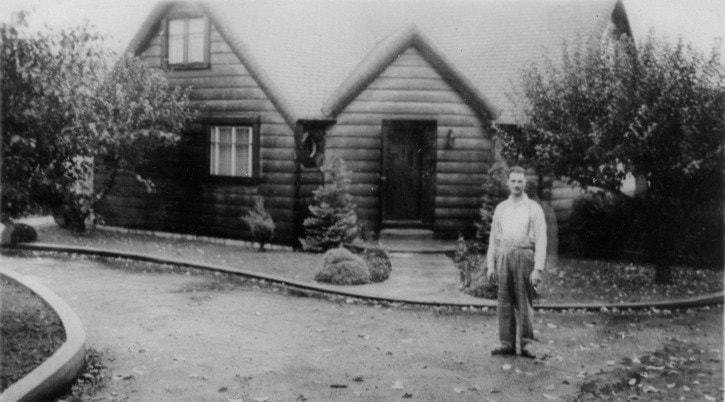Looking down toward the harbour as you drive through Sooke, and checking to see how the Mariners’ Village development is coming along, you see a house at the very bottom. It looks remarkably similar to the house in this photo, and that’s because it is indeed the same one, with logging entrepreneur Eric Bernard posed in front.
It was built by the Bernard logging crew during the 1940s, and stood right at the roadside, framed by the Throup family’s venerable apple trees that grew to the east. The apple orchard separated the Bernard house from the home of Jonas and Rebecca Throup, which still stands at time of writing.
The 1940s was a period of prosperity in the logging and pole cutting business, and Eric Bernard became known as a successful operator. The fine new home he built for his wife Marjorie and daughter Nadine was an example of the industrial opportunities of the times. Besides logging, pole cutting occupied many workers. Poles were tall, straight slender trees that were carefully felled and hauled out, initially by horses, before the heavy logging began on a setting.
Eric Bernard cut poles in several areas; some were felled in the Sooke Hills, trucked down Mt. Shepherd Road through Harbourview and dumped in the water at Cooper’s Cove for booming. Poles were in great demand during World War II, and many were destined to serve as utility poles throughout North America. We understand some even found their way as far as the islands in the Pacific Ocean.
While the Bernards enjoyed their new home, they also enjoyed special getaway weekends at Crabapple Lake, where Eric had built a beautiful log cabin. After Eric and Marjorie moved to the Cowichan Valley, their Sooke Road home (shown) was utilized for a variety of purposes, such as the office for the onetime Sooke Motel and as a fast foods outlet.
My next historical column will include a photograph of the pole yard in Saseenos adjacent to the CNR line (now residential homes) where poles were hauled to be loaded on to railcars for shipping out to market. That photo, too, was donated by Eric Bernard.
Elida Peers
Historian, Sooke Region Museum
